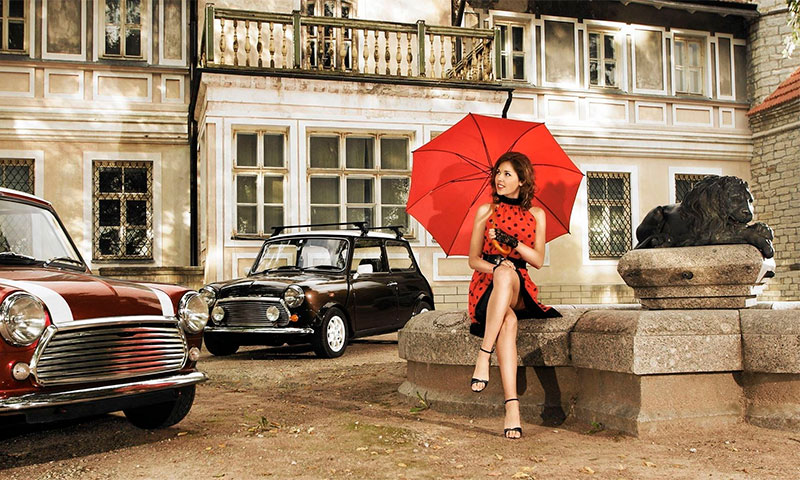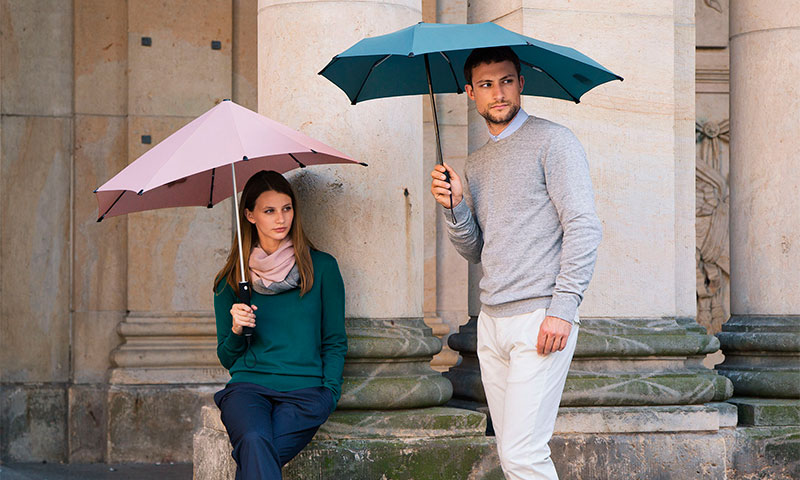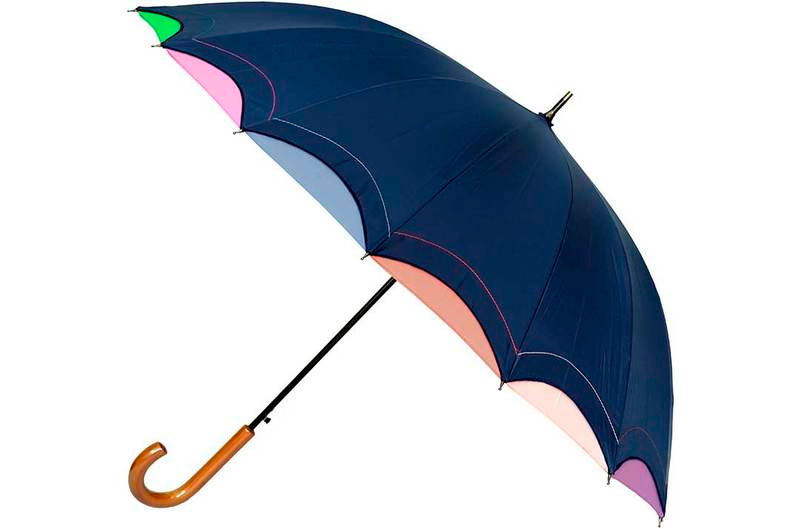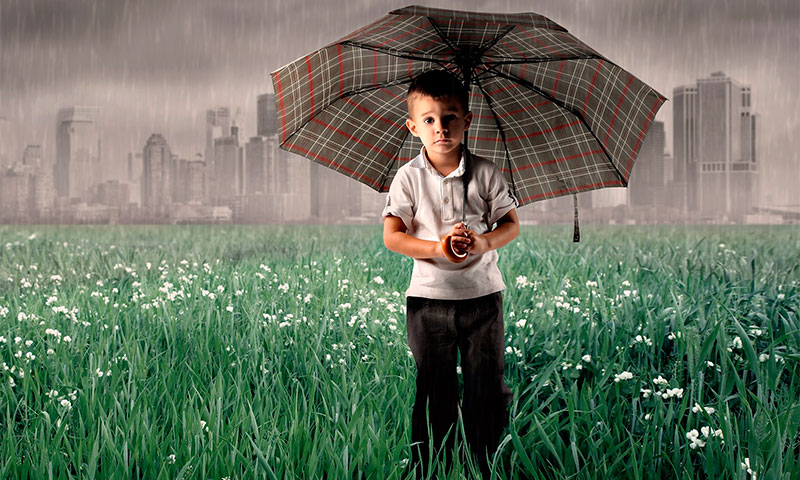Men's and women's, from rain and wind, absolutely transparent or with a bright print - umbrellas simply amaze with their diversity. But we persistently grab the first model you like from the counter and give money without even asking what the umbrella is made of. But it depends on how soon you return to the store for a new one. Let's stop mindlessly spending on unsuccessful umbrellas, and choose the very-most - one that will last more than one season.

Content:
The best umbrella manufacturers - which company to choose
When choosing an umbrella, we all look at two things first: the design and the label with the name of the manufacturer. For a start, this is enough, because an umbrella is a simple accessory, and the quality of workmanship largely determines its service life.
A good solution would be to buy any model from such companies:
- Three elephants;
- Fulton;
- Doppler;
- Happy Rain;
- Zest.
In our ranking of the best umbrellas, you will find models of these manufacturers with a complete description, as well as an analysis of their advantages and disadvantages. However, choosing a brand thing, you must ensure its authenticity, since there are quite a few fakes on sale.
But if you want to buy an umbrella that is not only durable, but also comfortable, you will need to pay more attention to detail.
The principle of operation and device umbrellas

Any umbrella, regardless of its purpose, consists of 3 main parts: a rod with a handle, a set of knitting needles and a tent (dome) fitting them.
1. The rod is the main supporting element of the whole structure, and it is believed that the service life of the umbrella depends on it. In fact, many of these accessories are sent to a landfill with a whole skeleton, and only frankly low-end models can be bent or broken “live”. The design of the rod is more important because it determines the height of the umbrella and its size when folded. It can be solid or telescopic and have a length of from 60 to 150 cm.
2. The spokes are certainly the most important part of any umbrella, since it is they who support its dome. Depending on the size and shape of the model, here they can be from 4 to 16, the presence of 8 spokes is considered optimal. But the wider the dome, the more they will need to support the tent.
3. The awning is a soft, waterproof fabric that forms a protective dome over your head. Round or similar tarpaulins are considered traditional, but they may well go in the form of some kind of symbol or even an animal, if it is a children's model. No less significant is the material from which the awning is made: it must be waterproof and strong enough to withstand wind gusts.
Types of umbrellas
From the rain

The overwhelming majority of manufactured umbrellas are designed to protect against rain and sleet. They have a fairly strong frame that can withstand weak gusts of wind. But the main role here is played by a waterproof awning, which does all the “work”.
Pros:
- Water repellent and windproof dome material;
- Moderately durable knitting and rod construction;
- A huge range of different models;
- Wide price range.
Minuses:
- With strong gusts of wind, the dome turns inside out.
From the sun

These are light lace umbrellas that protect the weaker floor from the scorching rays. Were in fashion a couple of centuries ago, when women valued aristocratic pallor, but with today's aggressive sun, their use remains relevant.
Such things are made of light, but fairly durable materials, although not designed for bad weather. Nevertheless, among them there are models with waterproof awning.
Pros:
- Attractive design;
- Good UV protection;
- Rain protection is possible (depending on the model);
- A light weight;
- Reasonable cost, if it is, of course, not a designer thing, made to order.
Minuses:
- The design will not withstand strong winds;
- Few women of fashion dare to make such a purchase.
From the wind

An even more rare type of umbrellas with a very non-standard dome, more like a huge helmet or an asymmetrical pyramid. This design allows the umbrella to keep its shape and not turn out, even with heavy gusts of wind up to 30 m / s. But in general, these are all the same good old umbrellas from the rain, but very much of an unusual style.
Pros:
- Reliable protection from rain and strong winds;
- Due to the design features, it does not turn out or break the needles;
- Reinforced frame.
Minuses:
- Appearance on the fan;
- Rarely found in stores.
Umbrella canes

These are rather large accessories with a long (up to 150 cm) solid rod and a wide opening of the dome, reaching 1 meter in diameter. Such umbrellas are designed not only for protection from the weather, but also can serve as the completion of your image. However, the majority of children's models with some stretch can also be attributed to the canes.
Pros:
- Due to the absence of a folding mechanism more reliable and durable;
- Mandatory hook handle - comfortable to wear on the elbow;
- The wide dome reliably protects the head and shoulders;
- Classic rigorous design;
- Can be used as a regular cane.
Minuses:
- High price;
- Dimensional and not very convenient to store.
Mechanical

Such umbrellas are considered the most reliable in the whole family, but they need to be opened and closed only manually. To do this, stretch a ring along the rod, to which the spokes are attached with one end while drowning or lowering the latch tongue. And the telescopic handle simply extends until click. When folded, this umbrella has a length of 16 to 90 cm and does not take up much space.
Pros:
- Compactness (up to 5 additions);
- High strength and reliability of a simple mechanism;
- Acceptable cost.
Minuses:
- The need to fold and fold the umbrella by hand;
- When assembling will have to make an effort.
Semi automatic

These models are slightly more modern and easier to use than mechanical ones. They open when you press the button located on the handle, but you still have to fold the umbrella manually. Such designs are the most common, because they have an ideal price / quality ratio.
Pros:
- Moderately durable;
- Compact, like all folding models;
- Easy to open with one click;
- Wide range of;
- Adequate price.
Minuses:
- The same, as at mechanics - manual folding with some effort.
Automatic

The most convenient models in use which open and develop independently - it is worth pressing the button on the handle. A great option if during the rain you need to quickly jump into the transport or the entrance, instead of getting wet, trying to close the umbrella manually.
Pros:
- The most convenient to use;
- Compact;
- Made from lightweight and durable modern materials.
Minuses:
- The device is more complicated, so the risk of breakdowns increases;
- High price.
Umbrella selection options

Awning material
Choosing an umbrella, you need not only to admire the print printed on it, but also to ask the seller what its dome is made of. It depends on how long your purchase will last.
Today, accessories manufacturers offer such options:
1. Nylon is an inexpensive synthetic fabric with medium waterproof performance. It is good enough to protect from rain, but it can tear if it is in strong winds. After prolonged use, it sheds and fades.
2. Polyester (can go with teflon impregnation) - more expensive and reliable material. This fabric does not "sit down", perfectly protects from wetting and dries very quickly.Regardless of the number of past seasons, such an umbrella will not lose the brightness of colors, but, like nylon, it can break in strong winds.
3. Pongee - mixed fabric of nylon and polyester. Reliable, durable and expensive material. The dome of the pongee does not let in water, dries quickly, and most importantly, it does not wipe and does not tear.
4. Sateen with water-repellent impregnation - the most expensive material, which is used for elite umbrellas. Perfectly protects the owner in any bad weather, does not tear and dries very quickly.
5. Vinyl or polyethylene - these materials are used to produce transparent umbrellas (usually with a deep and narrow dome). Through their walls it is convenient to observe what is happening around, which is impossible with conventional models. Alas, a thin transparent film is absolutely short-lived and will easily break even in a bag.
Knitting needles and rod
Spokes - the most problematic part of any umbrella. Therefore, when choosing, pay attention to their quality and the number of attachment points to the awning - this will allow you to understand how your umbrella is protected from damage. Well, if they have a spring-loaded structure, then when the dome is turned out, they will simply open in the opposite direction, but they will not break.
Spokes and pivot are almost always made:
1. Steel - strong and durable, but very heavy. Such an umbrella will have considerable weight.
2. Fiberglass - has a certain elasticity and good wear resistance with low weight. In terms of strength, it is inferior only to steel.
3. Aluminum is the lightest, but short-lived material that can bend even with a strong gust of wind.
As for the design of the rods, if you want a folding model, you have to find a compromise between the compactness of the accessory and its service life. Umbrellas can fold from 2 to 5 times, and the more joints they have, the higher the risk of breakage.
Which umbrella to choose

1. For a man you need a large folding umbrella or a cane with a strict design and discreet colors. It should have a massive handle - under a wide palm and a strong steel frame. Men's umbrellas usually serve for many years, so it is better to immediately take an expensive model with an awning from pongee or satin.
2. Women fit umbrellas of medium size with a bright and interesting coloring. A narrow handle in the shape of a cylinder or in the shape of a letter U, if it is a cane, will be convenient. Rod and knitting needles are better to take from fiberglass, but you can save and limit to aluminum. The ideal choice would be automatic and semi-automatic models, folding 4-5 times - to fit in a handbag. The material of the awning does not play a special role, because ladies often change umbrellas, so regular nylon or polyester will be enough.
3. Children's umbrellas have a bright "cartoon" design and small size. The rod and the spokes are made of lighter materials (aluminum or fiberglass), the handle is plastic, small and completely lightweight. The ends of the spokes on the dome should cover large lining, precluding accidental injury when careless handling. Folding here is allowed only mechanically - also for safety reasons of the child. As for the tent, look for an inexpensive fabric like PE, nylon or take a cool transparent model with a dome of PVC film.
4. If you love summer walks in the countryside or on the beach, but have very delicate skin, take a sun umbrella with you. It not only creates a shadow, but also does not transmit ultraviolet radiation, protecting your skin. Also, lace umbrellas often buy brides who marry in the hot summer.
Cost of umbrellas

1. A male cane umbrella with a mechanical layout can be bought within 600-17000 rubles, and the cost of stylish female models sometimes reaches up to 20 thousand. The same design, but with a semiautomatic device is presented in a wider price range - from 400 to 24,000 rubles for men and no more than 15 thousand for women. Automation will cost from 1 to 7 thousand rubles for representatives of both sexes.
2. Folding umbrellas for men with manual layout cost 300-4000 rubles, for women there are chic accessories and at a higher price - up to 9000. Semi-automatic models start from 400-500 rubles and reach 13 thousand, ladies in this category are traditionally cheaper - not more than 8.5 thousand rubles. As for the folding machines, here women's umbrellas take the lead again. Their price range is 500-10000, while the strong half of humanity is quite enough to fit in the amount of 800 to 7500 rubles.
3. For children, manufacturers offer inexpensive umbrellas - from 160 rubles for a simple nylon to 2500 for a stylish transparent dome. By the way, ladies' lace parasols also appeared in the same price category.
4. Unusual models from the wind can be bought within 4-5 thousand rubles.
It will be interesting to friends too







